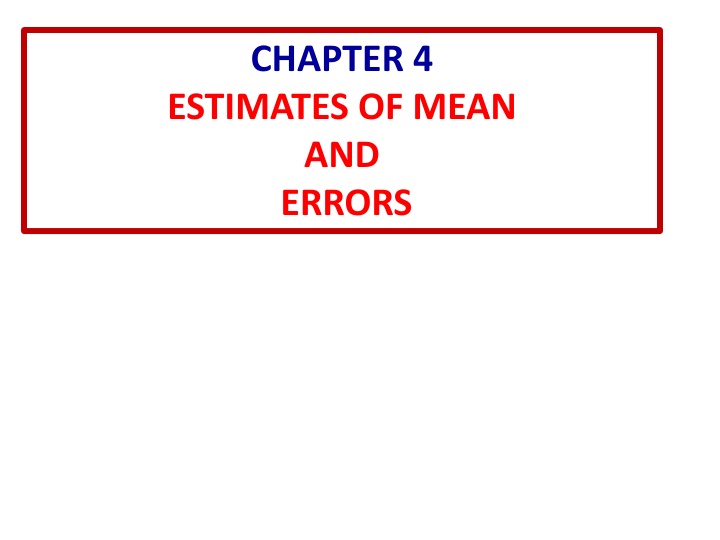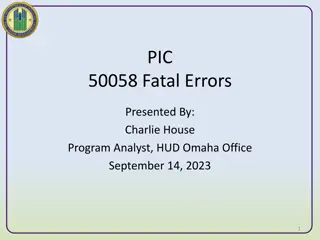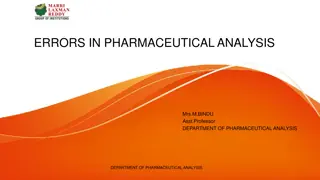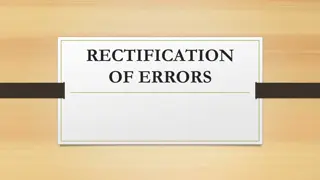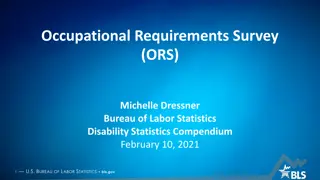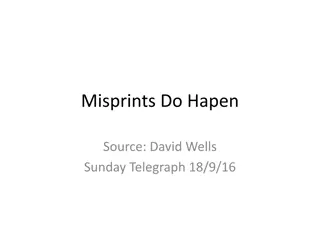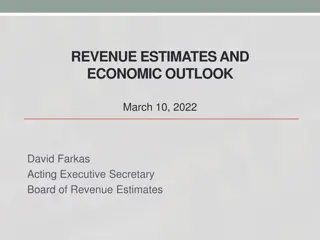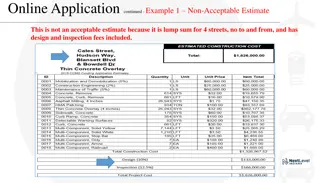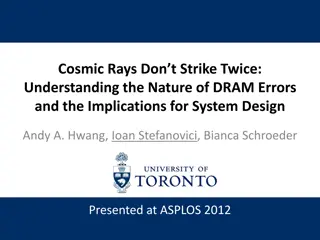Estimates of Mean and Errors in Data Analysis
In Chapter 4, we delve into the method of least squares for estimating the mean in data analysis. Through maximum likelihood, we explore how to derive the most probable value for the mean from a set of observations. The relevance of Gaussian and Poisson distributions, along with the calculation of errors, is discussed.
Download Presentation

Please find below an Image/Link to download the presentation.
The content on the website is provided AS IS for your information and personal use only. It may not be sold, licensed, or shared on other websites without obtaining consent from the author.If you encounter any issues during the download, it is possible that the publisher has removed the file from their server.
You are allowed to download the files provided on this website for personal or commercial use, subject to the condition that they are used lawfully. All files are the property of their respective owners.
The content on the website is provided AS IS for your information and personal use only. It may not be sold, licensed, or shared on other websites without obtaining consent from the author.
E N D
Presentation Transcript
CHAPTER 4 ESTIMATES OF MEAN AND ERRORS
4.1 METHOD OF LEAST SQUARES I n Chapter 2 we defined the mean of the parent distribution and noted that the most probable estimate of the mean of a random set of observations is the average x of the observations. The justification for that statement is based on the assumption that the measurements are distributed according to the Gaussian distribution. In general, we expect the distribution of measurements to be either Gaussian or Poisson, but because these distributions are indistinguishable for most physical situations we can assume the Gaussian distribution is obeyed. Method of Maximum Likelihood Assume that, in an experiment, we have observed a set of N data points that are randomly selected from the infinite set of the parent population, distributed according to the parent distribution. If the parent distribution is Gaussian with mean and standard deviation , the probability dPi for making any single observation xiwithin an interval dx is given by dPi =Pi dx (4.1) with probability function Pi = PG(xi , , ) [see Equation(2.23)]. For simplicity, we shall denote the probability Pifor making an observation xiby
Because, in general, we do not know the mean of the distribution for a physical experiment, we must estimate it from some experimentally derived parameter. Let us call the estimate ' , What formula for deriving ' from the data will yield the maximum likelihood that the parent distribution had a mean equal to ? If we hypothesize a trial distribution with a mean ' and standard deviation ' = , the probability of observing the value xi is given by the probability function Considering the entire set of N observations, the probability for observing that particular set is given by the product of the individual probability functions, Pi( '), denotes the product of the N probabilities Pi( '). where the symbol The product of the constants multiplying the exponential in Equation (4.3) is the same as the product to the Nth power, and the product of the exponentials is the same as the exponential of the sum of the arguments. Therefore, Equation (4.4) reduces
According to the method of maximum likelihood, if we compare the probabilities P("",') of obtaining our set of observations from various parent populations with different means "",' but with the same standard deviation (J"' = (J", the probability is greatest that the data were derived from a population with "",' = ""'; that is, the most likely population from which such a set of data might have come is assumed to be the correct one. Calculation of the Mean The method of maximum likelihood states that the most probable value for "",' is the one that gives the maximum value for the probability P("",') of Equation (4.5). Because this probability is the product of a constant times an exponential to a negative argument, maximizing the probability P("",') is equivalent to minimizing the argument X of the exponential, (4.6) To find the minimum value of a function X we set the derivative of the function to 0, (4.7)
and combining Equations (4.10) and (4.11), we obtain (4.12) for the estimated error in the mean (J' fL" Thus, the standard deviation of our determination of the mean fL I and, therefore, the precision of our estimate of the quantity fL, improves as the square root of the number of measurements. The standard deviation (J' of the parent population can be estimated from a consideration of the measuring equipment and conditions, or internally from the data, according to Equation (1.8): (J' = s = ) N ~ 1 ~ (Xi - X)2 (4.13) which gives for the uncertainty (J' /L in the determination of the mean (J' S (J' =--=-- /L vN vN (4.14) where (J' /L is referred to as the standard deviation of the mean, or the standard error. In principle, the value of (J' obtained from Equation (4.13) should be consistent with the estimate made from the experimental equipment. It is important to realize that the standard deviation of the data does not decrease with repeated measurement; it just becomes better determined. On the other hand, the standard deviation of the mean decreases as the square root of the number of measurements, indicating the improvement in our ability to estimate the mean of the distribution. Graphically we could illustrate this improvement by plotting a
Example 4.1 We return to the student's measurement of the dropped ball (Example 1.2). Let us assume that the time for the ball to fall 2.00 m had been established previously by careful measurements to be Test = 0.639 s. The student drops the ball 50 times and concludes, from a consideration of the electronic timer and the experimental arrangement that the uncertainty in each of his individual measurements is 0.020 s, consistent with the standard deviation determined from the data. This finite precision of the apparatus results in a spread of observations grouped around the established time as illustrated by the histogram of the data in Figure 1.2. Because the uncertainties in all the data points are equal (s; = s), the student calculates from his measurements and Equation (4.9) that his estimate of the mean time is f.1 = T = 0.635s, with a standard deviation from Equation (4.13) of a = s = 0.020 s. From Equation (4.14), he estimates the uncertainty in his determination of the mean to be a /L = sfYN = 0.020fVsO or a /L = 0.0028. He quotes his experimental result as Texp = (0.635 0.003) s. To compare his experimental value Texp to the established value Test' the student calculates the number of standard deviations by which the two differ n = IT - T If a , exp est /l. = 1A. From the integral of the Gaussian probability equation in Table C.2, we observe that we might expect a measurement to be within lA standard deviations in about 83.8% of repeated experiments, or to exceed 1A standard deviations in about 16.2% of the cases. It is i
A Warning About Statistics Equation (4.12) might suggest that the error in the mean of a set of measurements Xi can be reduced indefinitely by repeated measurements of Xi. We should be aware of the limitations of this equation before assuming that an experimental result can be improved to any desired degree of accuracy if we are willing to do enough work. There are three main limitations to consider: those of available time and resources, those imposed by systematic errors, and those imposed by nonstatistical fluctuations. The first of these limitations is a very practical one. It may not be possible to take enough repeated measurements to make a significant improvement in the standard deviation of the result. The student of Example 1.2 may be able to make 50 measurements of the time, but might not have the patience to make four times as many measurements to cut the uncertainty by a factor of 2. Similarly, an experiment at a particle accelerator may be assigned 1000 hours of beam time. It may not be possible to increase the allocation to 16,000 hours to improve the precision of the result by a factor of 4. All experiments are subject to systematic errors at some level. Even after every possible effort has been made to understand the experimental equipment and correct for all known defects and errors of calibration, there comes a point at which further knowledge is unobtainable. For instance, any error in the placement of the detectors that measure times at the beginning and ending of the ball's fall in Example 1.2 will lead to a systematic uncertainty in the time (or in the distance through which the ball fell) and thus in the final result of the experiment. The phrase "nonstatistical fluctuations" can hide a multitude of sins, or at least problems, in our experiments. It is a rare experiment that follows the Gaussian distribution
Elimination of Data Points There will be occasions when we feel justified in eliminating or correcting outlying data points. For example, suppose that among the time measurements in Example 1.2, the student had recorded one as 0.86s. The student would likely conclude that he had meant to write 0.68s and either ignore or correct the point. What if one measurement had been recorded as O.72s? Should any action be taken? The point is about 4 standard deviations away from the mean of all the data points, and referring to Table C.2 we see that there is about a 0.06% probability of obtaining in a single measurement a value that is that far from the mean. Thus, in a sample of 50 such measurements we should expect to collect about 50 X 0.00006 = 0.003 such events. The established condition for discarding data in such circumstances is known as Chauvenefs criterion, which states that we should discard a data point if we expect less than half an event to be farther from the mean than the suspect point. If our sample point satisfies this requirement and, as long as we are convinced that our data do indeed follow the Gaussian distribution, we may discard the point with reasonable confidence and recalculate the mean and standard deviation. Thus, for the two examples cited in the preceding paragraph, it would be permissible under Chauvener's criterion to discard both the 0.86s and the O.72s data points. Removing an outlying point has a greater effect on the standard deviation than on the mean of a data sample, because the standard deviation depends on the squares of the deviations from the mean. Deleting one such point will lead to a
p(~,) = IT ( 1 )exp[-! L (x; - ~')2] ;= 1 (J'; yI2; 2 (J'; (4.15) Using the method of maximum likelihood, we must maximize this probability, which is equivalent to minimizing the argument in the exponential. Setting the first derivativ.e of the argument to 0, we obtain -!~ L (x; - ~')2 = L (x; -2~') = 0 2 d~ (J'; (J'; The most probable value is therefore the weighted average of the data points , _ L(X/(J'n ~ - L(1/(J'T) (4.16) (4.17) where each data point x; in the sum is weighted inversely by its own variance (J'T. Error in the Weighted Mean If the uncertainties of the data points are not equal, we evaluate a ~' / ax; from the expression of Equation (4.17) for the mean ~': a~' _ a L(X/(J'T) _ 1/(J'T ax; - ax; L(l/(J'T) - L(1/(J'l) (4.18) Substituting this result into Equation (4.10) yields a general formula for the uncertainty of the mean (J': 1/ (J'T 1 L [L(1/(J'nF = L(l/(J'T) (4.19) Relative Uncertainties
and the result depends only on the relative weights and not on the absolute magnitudes of the (J'i. To find the error in the estimate f.L' of the mean we must calculate a weighted average variance of the data: (J'2 = LWJXi - f.L')2 X ~ = (LWiXT _ 12) X ~ LWi (N - 1) LWi f.L (N - 1) (4.22) where the last factor corrects for the fact that the mean f.L 1 was itself determined from the data. We may recognize the expression in brackets as-the difference between the weighted average of the squares of our measurements Xi and the square of the weighted average. The variance of the mean can then be determined by substituting the expression for (J'2 from Equation (4.22) into Equation (4.14): (J'2 (J'2=- JL N (4.23) If they are required, the value of the scaling constant k and of the values of the separate variances (J'i can be estimated by equating the two expressions for (J' of Equations (4.14) and (4.19) and replacing 1/(J'T by kwi to give JL so (J'2 1 1 N L(l/(J'T) = kLWi k= N_l_ (J'2 LWi (4.24) (4.25)
The uncertainty (TIL in the mean is given by Equation (4.19): ( 40 10 )-1/2 (TIL = S = 0.012 + 0.0042 = 0.00099 V The result should be quoted as fL = (1.0196 0.0010)V although fL = (1.020 O.OOI)Vwould also be acceptable. Carrying the fourth place (which is completely undefined) after the decimal point just eliminates any possible rounding errors if these data should later be merged with data from other experiments. The precision of the final result in Example 4.2 is better than that for either part of the experiment. The uncertainties in the estimates of the means f.Ll and f.L2 determined from the two sets of data independently are given by Equation (4.14): S2 = 0.01 V ~ 0.0016 V V40 S2 = 0.004 V = 0.0013 V VW A comparison of these values illustrates the fact that taking more measurements decreases the resulting uncertainty only as the square root of the number of observations, which for this case is not so important as decreasing (J'i. What if the student did not know the absolute uncertainties in her measurements, but only that the uncertainties had been improved by a factor of 2.5? She could obtain the estimate of the mean directly from Equation (4.21) by replacing 1/(J'T by the weight Wi = 1, and 1/(J'~ by the weight Wi = 2.52, to give = 40(1)(1.022) V + 10(2.52)(1.018) V = 10196 V f.L 40(1) + 10(2.5)2 .
later distribution shows marked improvement over that of the earlier data, then we should seriously consider throwing away the earlier data unless we are certain of their reliability. There is no hard and fast rule that defines when a group of data should be ignored--common sense must be applied. However, we should make an effort to overcome the natural bias toward using all data simply to recover our investment of time and effort. Greater reliability may be gained by using the cleaner sample alone. 4.2 STATISTICAL FLUCTUATIONS For some experiments the standard deviations a i can be determined more accurately from a knowledge of the estimated parent distribution than from the data or from other experiments. If the observations are known to follow the Gaussian distribution, the standard deviation a is a free parameter and must be determined experimentally. If, however, the observations are known to be distributed according to the Poisson distribution, the standard deviation is equal to the square root of the mean. As discussed in Chapter 2, Poisson probability is appropriate for describing the distribution of the data points in counting experiments where the observations are the numbers of events detected per unit time interval. In such experiments, there are fluctuations in the counting rate from observation to observation that result solely from the intrinsically random nature of the process and are independent of any imprecision in measuring the time interval or of any inexactness in counting the number of events occurring in the interval. Because the fluctuations in the observations result from the statistical nature of the process, they are classified as statistical fluctuations, and the resulting errors in the final determinations are classified as
Here the Xi are the numbers of events detected in the N time intervals flt, and the assumption that the data were all drawn from the same parent population is equivalent to assuming that the lengths of the time intervals were the same for all measurements. According to Equation (2.19), the variance a 2 for a Poisson distribution is equal to the mean J.L: (4.28) The uncertainty in the mean atl'- is obtained by combining Equations (4.12) and (4.28): (4.29) We usually wish to find the mean number of counts per unit time, which is just J.Lt . h at. fI. J.L = flt WIt a I'- = flt = -V N flt (4.30) As we might expect, the uncertainty in the mean number of counts per unit time a I'is inversely proportional to the square roots of both the time interval flt and the number of measurements N. In some experiments, as in Example 4.2, data may be obtained with varying uncertainties. For purely statistical fluctuations, this implies that counts were recorded in varying time intervals flti If we wish to find the mean number of counts J.L per unit time from such data, there are two possible ways to proceed. If we have the raw data counts (the xJ and we know they are all independent, then we can simply add all the Xi and divide the sum by the sum of the time intervals: LX J.L = Lfl~. and a 2 = J.L
Example 4.3. The activity of a radioactive source is measured N = 10 times with a time intervall1t = 1 min. The data are given in Table 4.1. The average of these data points is .x = 15.1 counts per minute. The spread ofthe data points is characterized by a = 3.9 counts per minute calculated from the mean according to Equation (4.27). The uncertainty in the mean is calculated according to Equation (4.29) to be ax = 1.2 counts per minute. TABLE 4.1 Experimental data for the activity of a radioactive source from the experiment of Example 4.3 Interval t:.ti (min) 10 Tota120 Counts Xi 19 11 24 16 11 15 22 9 9
Note that, although we could have simplified matters by recording all the data as one experimental point, x = 298 counts per 20 minutes, by so doing, we wouldlose all independent information about the shape of the distribution that could be used as a partial check on the validity of the experiment. 4.3 PROBABILITY TESTS The object of our analysis is to obtain the best estimates, x and s"" of the mean J..L and its uncertainty 0'"" and to interpret the probability associated with the uncertainty as a measure of our success in determining the parent parameters. Regardless of the method used to make the measurements and analyze the data, we must always estimate the uncertainty in our results to indicate numerically our confidence in them. Generally, we relate the uncertainty to a Gaussian probability. We have noted that approximately 68% of the measurements in a Gaussian distribution fall within 1 standard deviation of the mean J..L. Thus, when we find the average of a large number of individual measurements, we expect the distribution of means to be Gaussian, centered on x = J..L with width s = 0', so that approximately 68% of our measurements of x would fall within the range (x - s) < x < (x + s). Similarly, if we were to repeat the entire experiment many times, we should expect our individual determinations of x to form a Gaussian distribution about the mean J..L, with width s'" = stYN = O'tYN. Again, we should expect that approximately 68% of our determinations of x should fall within the range (J..L - s",) < x < (J..L + s",). If we are convinced that we have made careful and unbiased measurements, we make a slight logical leap to state that there is approximately 68% probability that the true value of the mean J..L lies in the range (x - s",) < J..L < (x + s",) or that the specified
poorly determined. The probabilities that we calculate from the Gaussian distribution take no account of the latter problem. In such cases, a better estimate of the probability can be obtained from Student's t ~istribution, 1 which describes t?e distribution of the parameter t = Ix - xl/s fL , where t IS the number of standard deviations of the sample distribution S by which x differs from x. fL (t v) = _1_ r[(v + 1)/2] ( ~)-(V+J)/2 PI , vfv;) f(v/2) 1 + v where the gamma function fen) is equivalent to the factorial function n! extended to nonintegral arguments. (See Equation 11.7). Unlike the Gaussian distribution, Student's t distribution depends upon the number of degrees of freedom v. If x represents the mean of N numbers and x is not derived from the data, then v = N - 1. If both x and x are means, S must be the joint standard deviation of x and x, and v must be the total number of d:grees of freedom. In the limit of large v, Student's t and Gaussian probability distributions agree. As with the Gaussian distribution, we are usually interested in integrated values that relate to the probability of obtaining a result within a specific range t standard deviations. For example, we might wish to report our estimate of the probability that the true value of fL lies within the range (x - tSfL) < fL < (x + ts ) with t = Ix - fLlls . Table C.8 lists probabilities obtained by integrating the Student's t distributi~n from x = x - tSfL to x = X + tSfL for specified values of t and the number of degrees of freedom v. The corresponding values for Gaussian probability (which are independent
(v = 2), the Student's t probability for 95% confidence corresponds to a range of more than 40'. 4.4 CHI-SQUARE TESTS OF A DISTRIBUTION Once we have calculated the mean and standard deviation from our data, we may be in a position to say even more about the parent population. If we can be fairly confident of the type of parent distribution that describes the spread of the data points (e.g., Gaussian or Poisson distribution), then we can describe the parent distribution in detail and predict the outcome of future experiments from a statistical point of view. Because we are concerned with the behavior of the probability density function' p(x;) as a function of the observed values of Xi' a complete discussion will be postponed until Chapter 11 following the development of procedures for comparing data with complex functions. Let us for now use the results of Chapter 11 without derivation. The test that we shall describe here is the X2 (chi-square) test for goodness of fit. Probability Distribution If N measurements Xi are made of the quantity x, we can truncate the data to a common least count and group the observations into frequencies of identical observations to make a histogram. Let us assume that} runs from 1 to n so there are n possible different values of Xj' and let us call the frequency of observations, or number of counts in each histogram bin, hex) for each different measured value of Xj. If the probability for observing the value Xj in any random measurement is denoted by P(x), then the expected number of such observations is Y(Xj) = NP(x), where N is the total number of measurements. Figures 4.1 and 4.2 show the same six-bin histogram, drawn from a Gaussian parent distribution with mean fL = 5.0 and standard deviation 0' = 1,
frequencies J.Lj = y(x) with standard deviation (j/h) = ~ of the parent population as illustrated in Figure 4.2. However, in an actual experiment, we generally would not know these parameters. Definition of X2 With the preceding definitions for n, N, xi hex), P(x), and (j/h), the definition of X2 from Chapter 11 is (4.32) In most experiments, however, we do not know the values of (j/h) because we make only one set of measurements f(x). Fortunately, these uncertainties can be estimated from the data directly without measuring them explicitly. If we consider the data of Figure 4.2, we observe that for each value of Xj' we have extracted a proportionate random sample of the parent population for that value. The fluctuations in the observed frequencies hex) come from the statistical probabilities of making random selections of finite numbers of items and are distributed according to the Poisson distribution with y(x) as mean. Although the distribution of frequencies y(Xj) in Figure 4.2 is Gaussian, the probability functions for the spreads of the measurements of each frequency are Poisson distributions. For the Poisson distribution, the variance (jj(h)2 is equal to the mean y(Xj) of the distribution, and thus we can estimate (j/h) from the data to be (jj(h) = V NP(x) = vfh(;). Equation (4.32) simplifies to 2 n [h(x) - NP(x)F n [h(x) - NP(x)F X == 2: = 2: (4.33) j=! NP(x) j=! h(x)
even if NP(xj) is chosen completely independently of the distribution h (Xj) , there is still the normalizing factor N corresponding to the total number of events in the distribution, so that the expectation value of X2 must at best be (X2) = n - 1. In order to estimate the probability that our calculated values of X2 are consistent with our expected distribution of the data, we must know how X2 is distributed. If our value of X2 corresponds to a reasonable high probability, then we can have confidence in our assumed distribution. It is convenient to define the reduced chi-square as X~ == X2/V, with expectation value (X~) = 1. Values of X~ much larger than 1 result from large deviations from the assumed distribution and may indicate poor measurements, incorrect assignment of uncertainties, or an incorrect choice of probability function. Very small values of X~ are equally unacceptable and may imply some misunderstanding of the experiment. Rather than consider the probability of obtaining any particular value of X2 or X~ (which is infinitesimally small), we shall use an integral test to determine the probability of observing a value of X~ equal to or greater than the one we calculated. This is similar to our consideration of the probability that a measurement of a variable deviates by more than a certain amount from the mean. Table C.4 gives the probability that a random sample of data points drawn from the assumed probability distribution would yield a value of X2 as large as or larger than the observed value in a given experiment with v degrees of freedom. If the probability is reasonably close to 1, then the assumed distribution describes the spread of the data points well. If the probability is small, either the assumed
and standard deviation of the data, we have two additional constraints, the mean and standard deviation. Thus, for this comparison, the expectation value of X2 is v = 11 - 3 = 8. We obtained X2 = 7.85 and, thus, X~ = 0.98. The corresponding probability for obtaining a value X~ ;:::: 0.98 with 8 degrees of freedom is ~45%. Generalizations of the X2 Test In the preceding example we knew the parent distributions and were therefore able to determine the uncertainties erih) from the predicted probability. In most cases, where the actual parameters of the probability function are being determined in the calculation, we must use an estimate of the parent population based on these parameters and must estimate the uncertainties in the Y(Xj) from the data themselves. To do this we must replace the uncertainties in columns 4 and 7 of Table 4.2 with the square roots of the observed frequencies in column 2. ' Furthermore, although our example was clearly based on a simple probability function, the X2 test is often generalized to compare data obtained in any type of experiment to the prediction of a model. The uncertainties in the measurements may be instrumental or statistical or a combination of both, and the uncertainty erih)2 in the denominator of Equation (4.32) may represent a Gaussian error distribution rather than the Poisson distribution. In fact, several of the histogram bins in our example contained small numbers of counts, and thus, the statistical application of the test was not strictly correct, because we assume Gaussian statistics in the X2 calculation.
the quality of our data, and if we are concerned with statistical accuracy, we can merge the low-count bins to satisfy the Gaussian statistics requirement. Another application of the chi-squared test is in comparing two sets of data to attempt to decide whether or not they were drawn from the same parent population. Suppose that we have measured two distributions, g(x) and h(xj), and wish to determine the probability that the two sets were not drawn from the same parent probability distribution P(x). Clearly, we could apply the X2 test separately to the two sets of data and determine separately X2 probabilities that each set was not associated with the supposed parent population P(Xj). However, we can also make a direct test, independent of the parent population, by writing n [g(x) - h(x)F X2 = j~ a2(g) + a 2(h) (4.35) The denominator a 2(g) + a 2(h) is just the variance of the difference g(Xj) - h(x). As in the previous examples, the expectation value of X2 depends on the relation between the two parts of the numerator, g(x) and h(x). If the two parts, corresponding to the distributions of the two data sets, were obtained completely independently of one another, then the number of degrees of freedom equals nand (X2) = n. If one of the distributions g(x) or h(x) has been normalized to the other, then the number of degrees of freedom is reduced by 1 and (X2) = n - 1. Again, we interpret the X2 probability in a negative sense. If the value of X2/v is large, and therefore the probability given in Table C.4 is low, we may conclude that the two sets of data were
